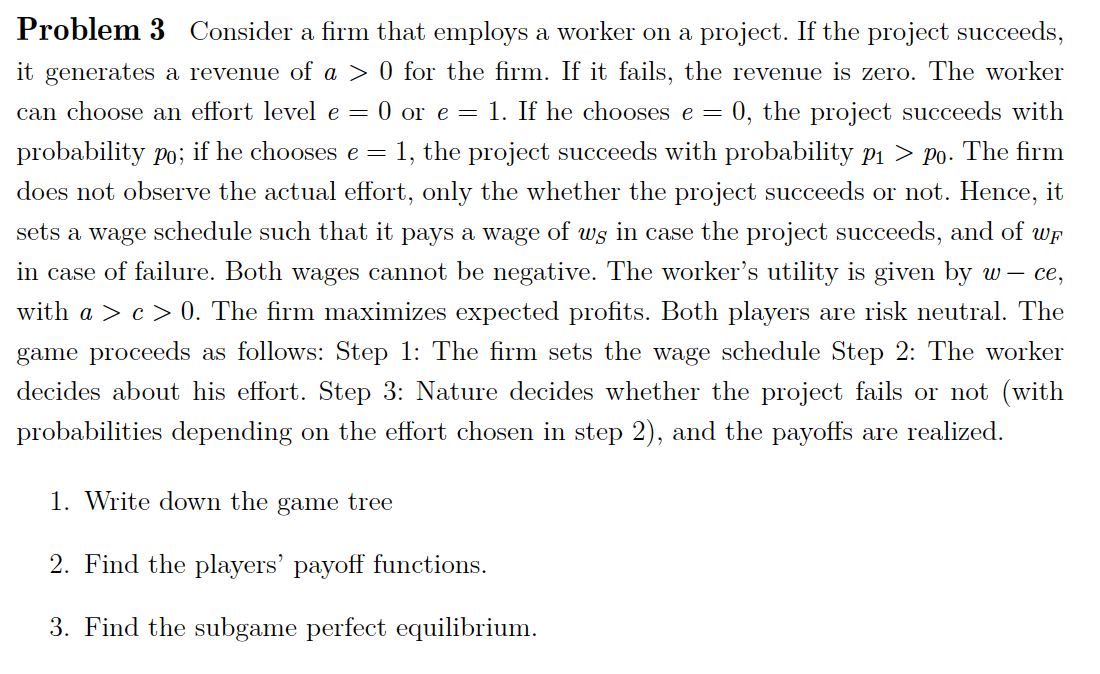Chapter1: Making Economics Decisions
Section: Chapter Questions
Problem 1QTC
Related questions
Question
! solved all parts

Transcribed Image Text:Problem 3 Consider a firm that employs a worker on a project. If the project succeeds,
it generates a revenue of a > 0 for the firm. If it fails, the revenue is zero. The worker
0, the project succeeds with
1, the project succeeds with probability p1 > p0. The firm
does not observe the actual effort, only the whether the project succeeds or not. Hence, it
can choose an effort level e = 0 or e = 1. If he chooses e =
probability po;
if he chooses e =
sets a wage schedule such that it pays a wage of ws in case the project succeeds, and of wp
in case of failure. Both wages cannot be negative. The worker's utility is given by w – ce,
with a > c> 0. The firm maximizes expected profits. Both players are risk neutral. The
game proceeds as follows: Step 1: The firm sets the wage schedule Step 2: The worker
decides about his effort. Step 3: Nature decides whether the project fails or not (with
probabilities depending on the effort chosen in step 2), and the payoffs are realized.
1. Write down the game tree
2. Find the players' payoff functions.
3. Find the subgame perfect equilibrium.
Expert Solution
This question has been solved!
Explore an expertly crafted, step-by-step solution for a thorough understanding of key concepts.
Step by step
Solved in 5 steps with 1 images

Knowledge Booster
Learn more about
Need a deep-dive on the concept behind this application? Look no further. Learn more about this topic, economics and related others by exploring similar questions and additional content below.Recommended textbooks for you


Principles of Economics (12th Edition)
Economics
ISBN:
9780134078779
Author:
Karl E. Case, Ray C. Fair, Sharon E. Oster
Publisher:
PEARSON

Engineering Economy (17th Edition)
Economics
ISBN:
9780134870069
Author:
William G. Sullivan, Elin M. Wicks, C. Patrick Koelling
Publisher:
PEARSON


Principles of Economics (12th Edition)
Economics
ISBN:
9780134078779
Author:
Karl E. Case, Ray C. Fair, Sharon E. Oster
Publisher:
PEARSON

Engineering Economy (17th Edition)
Economics
ISBN:
9780134870069
Author:
William G. Sullivan, Elin M. Wicks, C. Patrick Koelling
Publisher:
PEARSON

Principles of Economics (MindTap Course List)
Economics
ISBN:
9781305585126
Author:
N. Gregory Mankiw
Publisher:
Cengage Learning

Managerial Economics: A Problem Solving Approach
Economics
ISBN:
9781337106665
Author:
Luke M. Froeb, Brian T. McCann, Michael R. Ward, Mike Shor
Publisher:
Cengage Learning

Managerial Economics & Business Strategy (Mcgraw-…
Economics
ISBN:
9781259290619
Author:
Michael Baye, Jeff Prince
Publisher:
McGraw-Hill Education